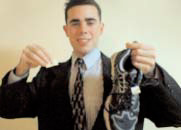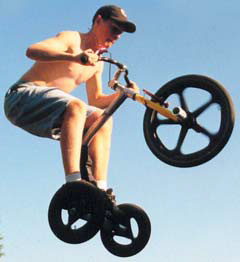Matthew Santaguida believes a good invention is something that saves people time. While brainstorming one night when he was 15 he came up with a simple yet ingenious way of keeping shoelaces tied. He called the vinyl-and-Velcro wrap “Stay Tie.”
 But deciding whether it was a “stupid or a great idea” was the toughest part in turning his idea into a money-making business. The first step and the hardest you will ever take, says the Toronto entrepreneur, is to believe in your invention. “My peers and even my family were telling me that ‘Stay Tie is stupid’ and, “You are just wasting your time,” (while) others said ‘It’s a great idea!’” says Santaguida, now 22. But whenever one setback came along, something else would come up to pick up his spirit and make him believe again in the potential of Stay Tie.
But deciding whether it was a “stupid or a great idea” was the toughest part in turning his idea into a money-making business. The first step and the hardest you will ever take, says the Toronto entrepreneur, is to believe in your invention. “My peers and even my family were telling me that ‘Stay Tie is stupid’ and, “You are just wasting your time,” (while) others said ‘It’s a great idea!’” says Santaguida, now 22. But whenever one setback came along, something else would come up to pick up his spirit and make him believe again in the potential of Stay Tie.
Evan Roche, 10, applies the same principle when he approaches his invention-turned-small-business-venture. Roche, of White Rock, B.C., has been in the market with The Cleanup Game since 1998 and encourages other young inventors to “always believe in yourself, even if you feel shy or nervous.” At the age of six he was never fond of cleaning up his room or  toys. He turned the boring task around and invented a board game that makes the idea of cleanup fun. He has sold close to 100 self-manufactured games.
toys. He turned the boring task around and invented a board game that makes the idea of cleanup fun. He has sold close to 100 self-manufactured games.
One of Canada’s best-known inventors came up with his idea—the snowmobile—when he was only 15. Joseph-Armand Bombardier was passionate about machines from an early age and also well-versed in the problems of travelling in snow as he grew up in Valcourt, east of Montreal. In 1922, he took the motor of a Ford Model T, attached it to the framework of a four-passenger sleigh, and added a huge wooden propeller. From there he built a company that bears his name that now manufactures jets, subway cars and recreational vehicles. Today Bombardier has 80,000 employees in 24 countries.
When Santaguida mustered enough courage to follow through on his Stay Tie invention he turned his drawings into prototypes. He first used different fabrics from old shirts, his mom’s sewing kit and Velcro purchased at a local hardware store. “I sewed it myself,” he says proudly of his first prototype. “I still have a scar from that experience.”
Young Canadian inventors like Santaguida and Roche usually don’t get much attention outside of science and school fairs, but they are out there, says Richard Parson, president of Inventors.ca Inc. Parson’s website is a one-stop service for inventors, incorporating advice, seminars, workshops and other links to innovation. Parson has encountered a lot of people who had great ideas but didn’t have anything to show for it. “It is important to build a prototype model,” he says. Not everything that looks good on paper works well when built. “It can also be a way to protect yourself,” Parsons says, especially if you don’t have a patent, which confirms the inventor’s ownership of the idea.
Parson discourages anyone who doesn’t have a solid idea of their invention from applying for a patent, which can cost at least $5,000. “Other people patent a vague idea that by the time the product is refined, the patent is no longer applicable,” Parsons says. However, Ursula McGuinness, a patent agent with Gowlings, Lafleur, Anderson, LLP. in Hamilton, Ontario, disagrees. She says that as soon as you have a concrete idea of the invention you should apply right away to protect yourself. You have at least a year to make slight changes to your invention without having to take out another patent.
Since Santaguida was not keen on selling his product himself, he first tried to sell his patent to shoe manufacturers but nothing came of that. So he then set out on his own with the encouragement of his family. Family functions became a way of m arketing his product and soon thereafter a website was up and running. A local newspaper’s mention of his product also served as a free ad. “I sold 300 in the first month from my website,” says Santaguida.
arketing his product and soon thereafter a website was up and running. A local newspaper’s mention of his product also served as a free ad. “I sold 300 in the first month from my website,” says Santaguida.
Ali Ardakani, vice-president of Tryke Inc., which sells an extreme sport vehicle invented by a 15-year-old, encourages inventors to treat their product seriously. “Sit down and write up a business plan.”
Vancouver teen Joui Miller was inspired by his little sister’s tricycle to come up with an oversized trike that can be used like a skateboard for doing tricks such as 180-degree jumps.
Santaguida, meanwhile, recently moved to South Korea for a full-time teaching job. Although he has contracted a company to sell Stay Tie while he is teaching, he is working on new packaging and gaining more ties to manufacturers in Korea. He’s hoping it’s a move that brings him closer to a much bigger goal—becoming a millionaire.
The University of Toronto Innovations Foundation recently conducted an online survey on what we considered to be the greatest Canadian inventions. Here are the top five picks and their inventors:
 Telephone
Telephone
Alexander Graham Bell
Bell received his telephone patent on March 7, 1876, four days after his 29th birthday.
Insulin
 Frederick Banting and Charles Best
Frederick Banting and Charles Best
Banting got his first idea of ways to produce insulin to treat diabetes in 1920, when he was a 29-year-old doctor. The next year he teamed up with Best, a 22-year-old medical student, and they started the work that led to its discovery.
Light bulb
 Henry Woodward and Matthew Evans
Henry Woodward and Matthew Evans
American Thomas Edison is usually credited with inventing the first electric light bulb, but Henry Woodward, a Toronto medical student, and his friend Matthew Evans actually patented it first, in 1875. They had no money to develop the idea so they sold their patent to Edison, who had the backing of industry investors.
Standard time
Sir Sandford Fleming
 Fleming was 52 when he recommended the concept of standard time zones in 1879. It was not his first invention. At the age of 21, he came up with a prototype of an in-line skate. And in 1851, when he was 28, he designed Canada’s first adhesive postage stamp.
Fleming was 52 when he recommended the concept of standard time zones in 1879. It was not his first invention. At the age of 21, he came up with a prototype of an in-line skate. And in 1851, when he was 28, he designed Canada’s first adhesive postage stamp.
Newsprint
 Charles Fenerty
Charles Fenerty
Around 1839, when he was about 18, Charles Fenerty, whose family owned lumber mills near Halifax, started experimenting with making paper from wood pulp. Before that, paper had been made from rags, which were often in short supply. He didn’t publicize his discovery until 1844, and by that time others had patented the process.
For more info. check out these sites:
Inventors Inc.
www.inventors.ca
Manning Awards
www.manningawards.ca
Canadian Intellectual Property Office
www.ipic.ca
Written for Faze by Jane T

Comments are closed.